Today, we are discussing how to Configure Visual Search for Edge Default Search Provider using Intune Policy. As we all know, Microsoft Edge provides a wide range of policy settings that can be managed through the Settings Catalog. Among these, one important policy is the one that specifies the Search-by-Image feature for the default search provider.
This policy allows administrators to define the search engine URL that will be used when users perform a reverse image search, ensuring better control, consistency, and security within the organization. The Search-by-Image feature in Microsoft Edge lets users do reverse image searches using their chosen search engine.
This is controlled by a policy that sets the URL Edge uses to send image search requests. The purpose of the policy this policy gives organizations control over how image searches are handled. If it’s not set, the feature won’t be available.
When enabled, it makes sure all image search requests go to the right search engine using the GET method. Administrators can configure the Search-by-Image feature in Microsoft Edge to work with providers like Bing and Google, or even set up a custom enterprise search URL.
Table of Contents
How can Admins Set up the Search-by-Image Feature in Microsoft Edge?
Admins can configure it by adding a Bing, Google, or custom enterprise search URL in the policy. This setting only works if the default search provider policies are also enabled. Using a custom URL gives organizations results, secure searches, and better compliance.
Configure Visual Search for Edge Default Search Provider using Intune Policy
We have already discussed many details about configuring Visual Search for Microsoft Edge with the default search provider using individual policies. Now, let’s look at how this policy can be configured through Microsoft Intune. The configuration stage is very important, as it determines how the settings will be applied across devices.
- First, we go to Device Configuration in Intune, and from there, we create a new policy.
- Next, fill in the Platform and Profile type details in the Create profile window.
- Set Platform to Windows 10 and later, and set Profile type to Settings catalog.
- Then click Create.
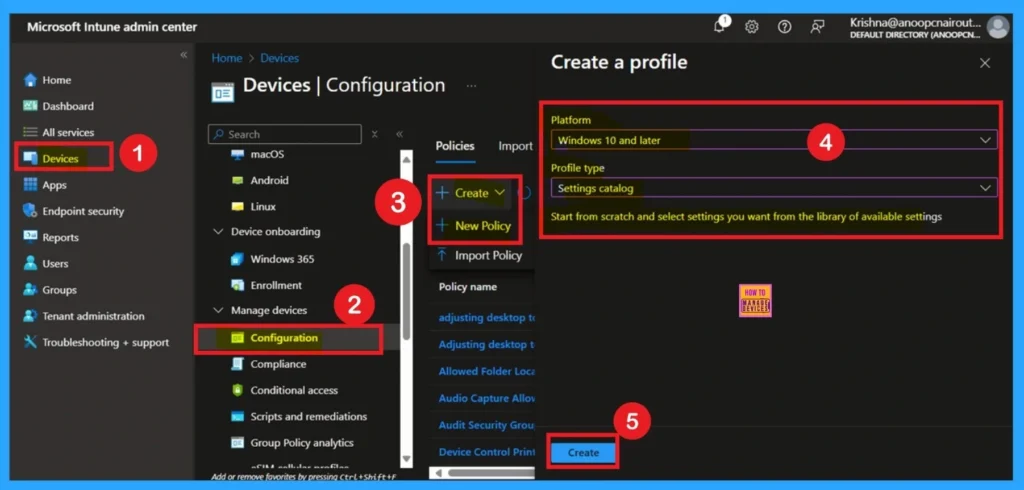
- Block Cookies in Microsoft Edge Using Intune
- How to Control Default Pop-up for Specific Sites Using Intune Policy
- Allow or Block Hardware Keyboard Text Suggestions in Text Input using Intune Policy
Basic Info
A policy name acts as its identification. In the Basics section, you need to provide a clear name for the policy so that it can be easily recognized later. You may also add a description to give more details about the purpose of the policy. The platform is already selected by default, so no changes are needed there. Once you have entered the name and description, click Next to continue.
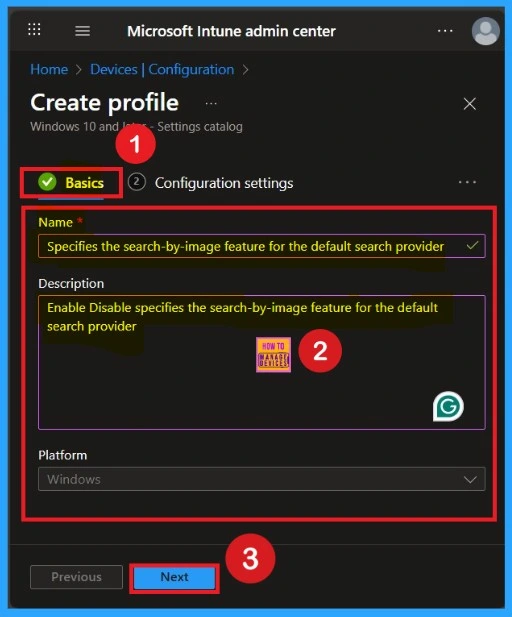
Know about the Configuration Settings
To start, click on the Add settings option (shown as a hyperlink). This will open the settings picker window. In the search bar, type Microsoft Edge, or scroll down to locate it manually. Under the Edge category, you will see different types of settings. From there, select Default search provider, and then choose the policy named Specifies the Search-by-Image feature for the default search provider.
- Once selected, close the settings picker window to continue with the configuration.
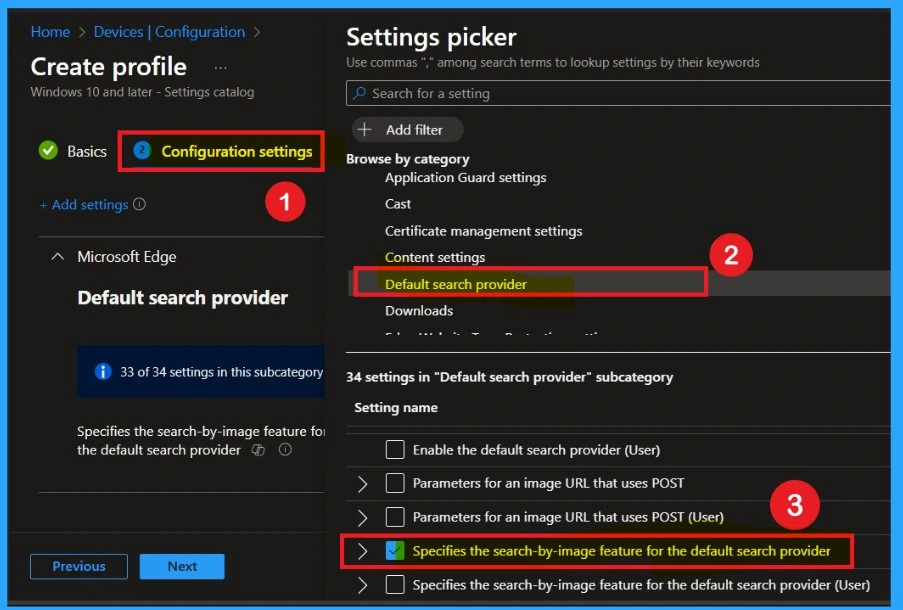
Understand the Defaulted Mode
By default, the policy mode is set to Disabled. If you want to keep this policy disabled, simply leave it as it is and click Next to continue. You can verify the below image for clarifications.
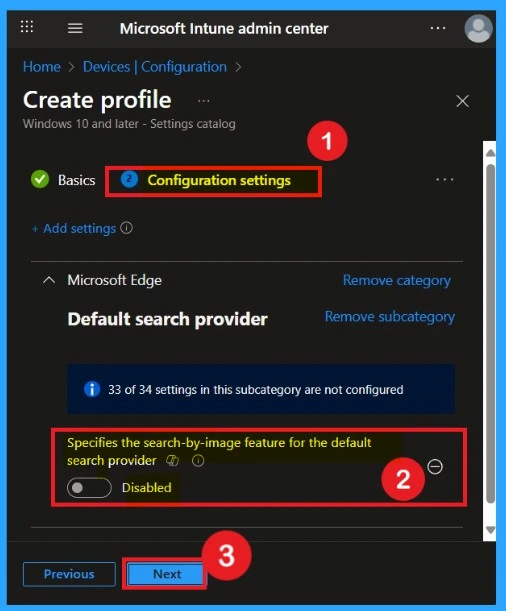
Let’s Enable the Policy
To enable the policy, simply switch the toggle from left to right. Once enabled, a text box will appear. Here, you must enter the appropriate URL for the policy configuration. After filling in the URL, click Next to continue.
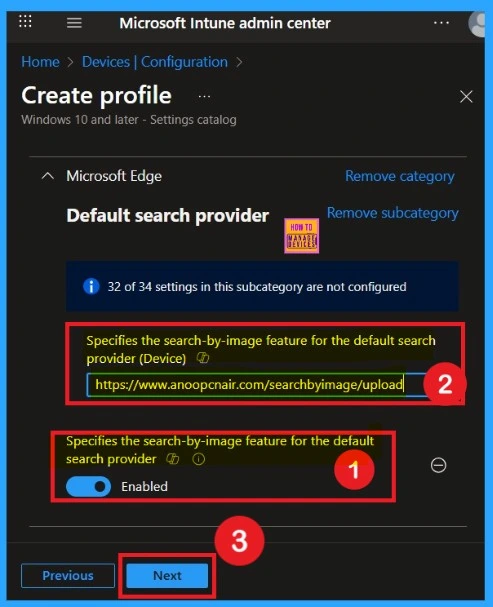
Scope Tags
Now you are on the Scope tags section. Scope tags are used to assign policies to specific admin groups for better management and filtering. If needed, you can add a scope tag here. However, for this policy, I chose to skip this section.
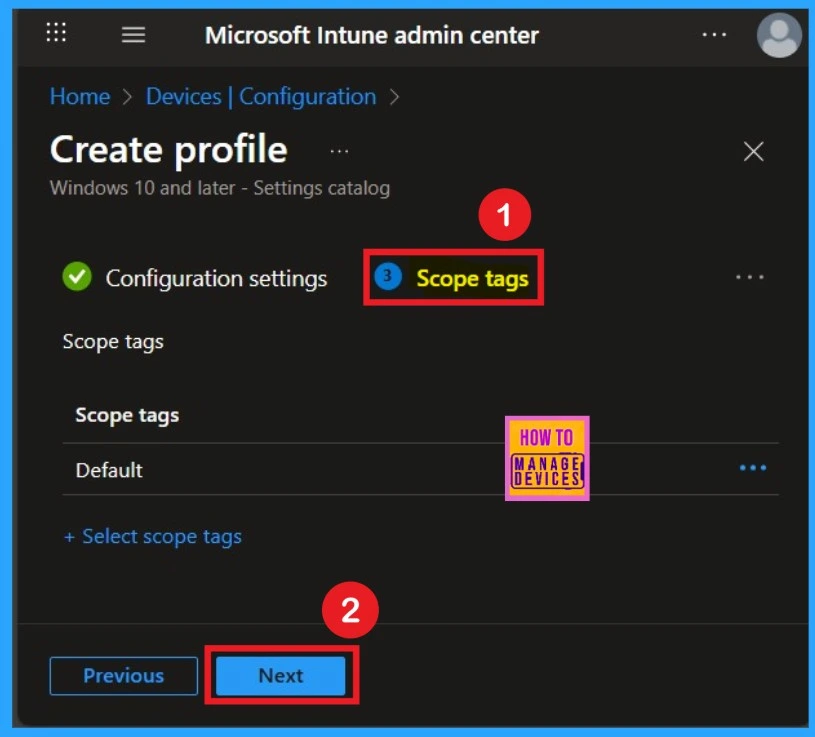
What are Assignments
Next, you’ll reach the Assignments section, which is a very important step. This is where you decide which user or device groups should receive the policy. In this case, I selected the specific group I wanted to apply the policy to. After selecting the group, click Next to continue.

Review + Create
The final step is the Review + Create tab, also known as the Summary tab. Here, you’ll find a complete overview of all the details and settings you’ve configured for the policy. Take a moment to review everything carefully. If everything looks fine, click Create to complete the process.
- If you spot any errors or need to make changes, you can return to the previous sections and update the information as needed.
- After clicking Create, you’ll receive a confirmation notification indicating that the policy has been successfully created.

Monitoring status
To check the status of a policy in the Intune portal, navigate to Devices > Configuration, then select the policy by name. Look for a status of Succeeded 1, which indicates that the deployment was successful. Keep in mind that the status may not update that time and wait a few minutes for the sync to finish before checking again.
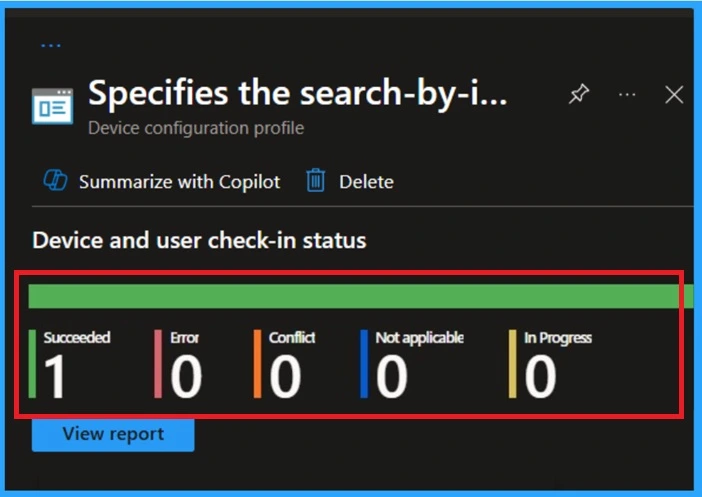
Client-Side Verifications
You can verify the confirmation in the Event Viewer by looking for Event ID 813 or 814. To access this, open Event Viewer and navigate to Applications and Services Logs > Microsoft > Windows >Device Management Enterprise Diagnostic Provider > Admin.
- You can see a list of policy-related events now.
- I found the policy details in the Event ID 814.
| Policy Details |
|---|
| MDM PolicyManager: Set policy string, Policy: (DefaultSearchProviderlmaqeURL), Area: (microsoft_edqe~Policy~microsoft_edqe~DefaultSearchProvider), EnrollmentlD requesting merqe: (EB427D85-802F-46D9-A3E2-D5B414587F63), Current User: (Device), Strinq: ( ), Enrollment Type: (0x6), Scope: (0x0). |
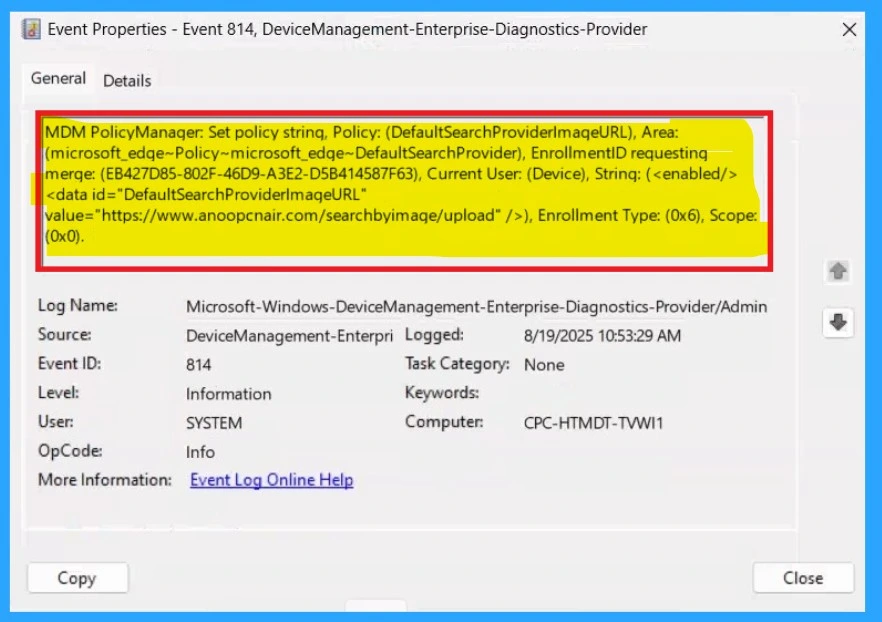
How to Delete a Policy Permenently
If you want to permanently delete a policy, search for the policy name in the Configuration search bar. Once the policy appears, click on the 3-dot menu next to it. You will see 3 options: Duplicate, Export, and Delete. Select Delete, and the policy will be permanently removed.
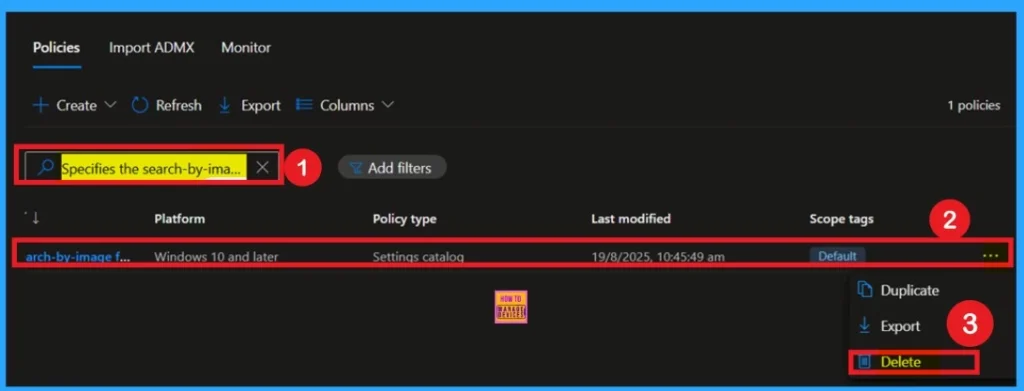
Remove Assigned Policy Group
If you want to remove a group from a policy, go to the Configurations section and select the policy. This will take you to the Monitoring status page. Scroll down to the Assignments section, where you will find an Edit option. Click on it to view the groups currently assigned to the policy. From there, you can remove the groups you no longer want assigned.
- Once done, click Review + Create to save the changes.
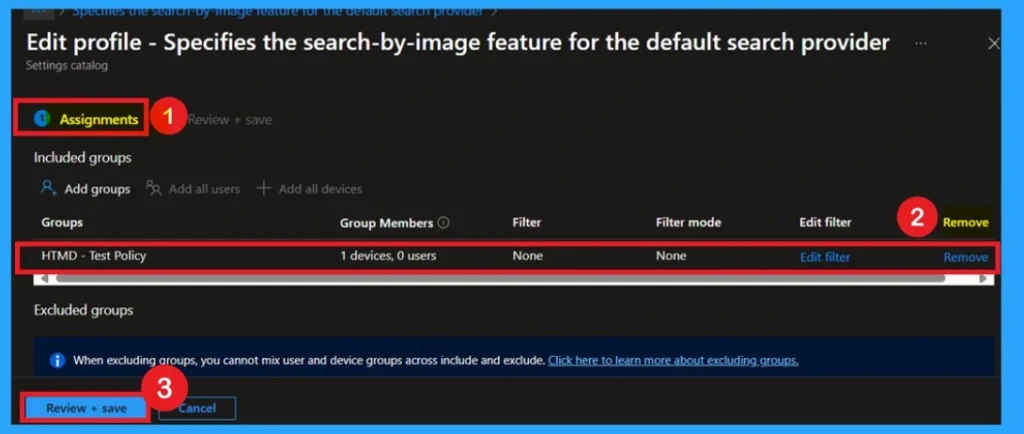
Need Further Assistance or Have Technical Questions?
Join the LinkedIn Page and Telegram group to get the latest step-by-step guides and news updates. Join our Meetup Page to participate in User group meetings. Also, join the WhatsApp Community to get the latest news on Microsoft Technologies. We are there on Reddit as well.
Author
Anoop C Nair has been Microsoft MVP for 10 consecutive years from 2015 onwards. He is a Workplace Solution Architect with more than 22+ years of experience in Workplace technologies. He is a Blogger, Speaker, and Local User Group Community leader. His primary focus is on Device Management technologies like SCCM and Intune. He writes about technologies like Intune, SCCM, Windows, Cloud PC, Windows, Entra, Microsoft Security, Career, etc.
